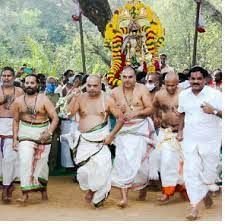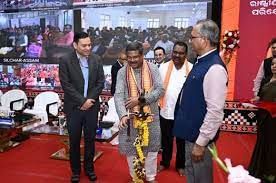UPSC Daily Current Affairs- 22nd February 2024 | Current Affairs & Hindu Analysis: Daily, Weekly & Monthly PDF Download
GS-I
Paruveta Festival
Subject: History & Culture
Why in News?
The Indian National Trust for Art and Cultural Heritage (INTACH) is making efforts to secure UNESCO recognition for the annual 'Paruveta' festival.
About Paruveta Festival:
- The festival, also known as the ‘mock hunting festival’, is celebrated at the Sri Narasimha Swamy temple in the town of Ahobilam, Andhra Pradesh.
- It is celebrated by all sections of people, irrespective of their caste.
- It is a festival of communal harmony, as devotees from other religious communities like Muslims also offer prayers to the Lord.
- Origin:
- According to folklore, Lord Vishnu, upon his incarnation as a man-lion (Narasimha) in Ahobilam, married Maha Lakshmi, born as a tribal girl Chenchulakshmi.
- The Kurnool District Gazetteers, published by Government Press in 1881, record several beliefs of the Chenchu tribes, including their reverence for Ahobila Narasimha as their brother-in-law and inviting him home for Makar Sankranti.
- While Paruveta rituals are commonly observed in many temples during Vijayadashami or Sankranti, at Ahobilam, it is conducted for a ‘mandala’ (forty days).
- Activities:
- During the festival, the deity from the temple's inner sanctum is taken to the 32 Chenchu tribal villages surrounding Ahobilam town for a duration of 40 days.
- The spiritual sojourn starts with the tribals aiming their bow and shooting two arrows at the palanquin, not only as a mark of reverence but also to show that the deity is under their protective cover.
- Chenchus take ‘Narasimha Deeksha’ by wearing yellow robes and ‘Tulasi Mala’ and observe celibacy during this period.
- The temple staff stay in these hamlets for the entire period, indicating the presence of a casteless society in the past with no hint of untouchability.
Key Facts about Chenchu Tribes:
- They live in the hills of southern India, primarily in the state of Andhra Pradesh.
- Other Chenchu communities can be found in the states of Tamil Nadu, Karnataka, and Orissa.
- Their native language (also called Chenchu) belongs to the Dravidian language family. Many also speak Telugu.
- Many Chenchu have been forced out of their traditional wandering, food-gathering lives by the growing number of peasant farmers. They now work as farmers or forest labourers.
- They live in hive-shaped houses made of wattle thatch (poles intertwined with twigs, reeds, or branches).
- Chenchu society consists of clans (extended family units), local groups, and families.
- They are exogamous, which means that they do not allow marriage within the same clan.
- They are also patrilineal, tracing the line of descent through the males.
Source: Times of India
GS-II
Model Code of Conduct
Subject: Polity

Why in News?
An Indian delegation is set to leave for London in an effort to seal the free trade agreement with the UK, as dates for the general elections are expected to be announced in less than a month, which will trigger the Model Code of Conduct (MCC).
Background:
- For the previous general elections in 2019, the MCC had come into force in the first half of March, and its presence may impede the Central Government’s ability to provide commitments in any FTAs till a new regime is sworn in post-elections.
About MODEL CODE OF CONDUCT (MCC)
- The Model Code of Conduct (MCC) is a set of guidelines issued by the Election Commission of India (ECI) for the conduct of political parties and candidates during elections.
- The MCC aims to ensure free and fair elections and to prevent any misuse of power or resources by the ruling party or government.
- As per the Election Commission of India, the model code of conduct was first observed during the 1960 polls (Kerala State Election) and since 1991 it has become an integral part of Indian election.
- The MCC comes into force from the date the election schedule is announced until the date that results are out.
- The MCC is not legally binding, but the ECI can take action against the violators under the Representation of the People Act, 1951 and the Indian Penal Code, 1860.
- The ECI can also use its constitutional powers under Article 324 to issue orders and directions to ensure compliance with the MCC.
Source : CNBC
Rashtriya Udyamita Vikas Pariyojana
Subject: Government Schemes

Why in News?
Recently, the Union Minister of Education and Skill Development & Entrepreneurship inaugurated the Rashtriya Udyamita Vikas Pariyojana, in Sambalpur, Odisha.
About Rashtriya Udyamita Vikas Pariyojana:
- It is tailored specifically for beneficiaries of the PM SVANidhi scheme, this unique National Entrepreneurship Development Project underscores the government's steadfast commitment to nurturing job providers across the nation.
- Aim: It aims to equip individuals with comprehensive entrepreneurship training, creating job providers rather than job seekers.
- This initiative focuses on reskilling and upskilling employees to enhance their competitiveness and adaptability in an era of disruptive technology.
- It will offer comprehensive entrepreneurship training over a period of 22 weeks, combining theoretical knowledge with practical exposure through experiential learning.
- The training will be conducted through offline, online and hybrid modes, with certificates awarded upon completion, enhancing the course's credibility and value.
- The Government of India has partnered with Flipkart to skill street vendors and small shopkeepers.
- Under the pilot program, street vendors in 10 big cities of the country will be given a stipend along with training to expand their businesses.
Source: PIB
Notable Jurist Fali S Nariman Passes Away at 95
Subject: Polity and Governance

Why in News?
Fali S. Nariman, an eminent jurist and Senior Advocate, left an indelible mark on India’s legal landscape over his illustrious 75-year career.
- Representing clients in a multitude of landmark cases, his contributions reshaped constitutional jurisprudence and safeguarded democratic principles.
Legacy in Indian Jurisprudence
[1] Upholding Judicial Independence: The Second Judges Case
- Legal Battle: Advocating before the Supreme Court Advocates-on-Record Association v. Union of India (1981), Nariman challenged the interpretation of “consultation” in judicial appointments, emphasizing its binding nature to preserve judicial autonomy.
- Judicial Triumph: Nariman’s advocacy led to the establishment of the Supreme Court Collegium, ensuring transparent and independent judicial appointments, a landmark decision that endures to this day.
[2] Clarifying Judicial Procedures: The Third Judges Case
- Presidential Reference: Nariman contributed to the Supreme Court’s deliberations in Special Reference 1 (1998), facilitating a structured consultative process for judicial appointments, reinforcing the judiciary’s collective responsibility.
- Expanded Collegium: His efforts expanded the scope of judicial consultation, enhancing transparency and accountability in the appointment process.
[3] Protecting Judicial Independence: National Judicial Appointments Commission Case
- Challenging Executive Interference: In Supreme Court Advocates-on-Record Association v. Union of India, Nariman vehemently opposed the National Judicial Appointment Commission Act, 2014, safeguarding judicial autonomy against executive overreach.
- Triumph for Collegium System: His advocacy contributed to the reinstatement of the collegium system, preserving the judiciary’s prerogative in judicial appointments.
[4] Championing Fundamental Rights: Golak Nath v. State of Punjab Case
- Constitutional Challenge: Nariman’s intervention in Golak Nath v. State of Punjab (1967) underscored Parliament’s limitations in amending fundamental rights, reinforcing the sanctity of constitutional provisions.
- Protecting Liberties: His advocacy upheld the inviolability of fundamental rights, ensuring the primacy of constitutional principles.
[5] Bhopal Gas Tragedy: Union Carbide Corporation v. Union of India (1989)
- Navigating Tragedy: Nariman’s representation of Union Carbide in the aftermath of the Bhopal gas tragedy facilitated a landmark settlement, ensuring timely compensation for victims and environmental remediation.
[6] Safeguarding Minority Rights: TMA Pai Foundation v. State of Karnataka
- Advocating Pluralism: Nariman’s involvement in TMA Pai Foundation v. State of Karnataka underscored the constitutional protection of minority rights in education, fostering inclusivity and diversity in the educational landscape.
[7] Upholding Constitutional Norms: Nabam Rebia v. Deputy Speaker
- Restoring Constitutional Order: Nariman’s intervention in Nabam Rebia v. Deputy Speaker (2016) reaffirmed the constitutional mandate for gubernatorial action, preserving democratic governance and institutional integrity.
[8] Ensuring Legal Fairness: J. Jayalalithaa v. State of Tamil Nadu
- Securing Justice: Nariman’s successful bail plea for Jayalalithaa exemplified his commitment to due process, ensuring equitable legal treatment for all individuals before the law.
[9] Resolving Inter-State Disputes: State of Karnataka v. State of Tamil Nadu
- Navigating Complexities: Nariman’s representation in the Cauvery water dispute showcased his dedication to resolving interstate conflicts through legal avenues, contributing to the equitable allocation of vital natural resources.
Conclusion
- Fali S. Nariman’s illustrious legal career stands as a testament to his unwavering commitment to justice, constitutionalism, and the rule of law.
- His profound influence on Indian jurisprudence reverberates through landmark decisions and enduring legal principles, leaving an indelible mark on the nation’s legal landscape.
Source: Indian Express
GS-III
Financial Stability and Development Council (FSDC)
Subject: Economy

Why in News?
Fresh measures to curb unauthorised online lending apps’ operations could be on the anvil, following deliberations on the issue at the Financial Stability and Development Council (FSDC) chaired by Finance Minister Nirmala Sitharaman on Wednesday.
Background:
- The FSDC, which has all financial sector regulators on board including the Reserve Bank of India, also discussed issues related to macro financial stability and the country’s preparedness to deal with any challenges that may come up.
About Financial Stability and Development Council (FSDC):
- It is non-statutory apex council constituted by the Executive Order in 2010.
- It works under the Ministry of Finance
- The Raghuram Rajan committee (2008) on financial sector reforms first proposed the creation of FSDC.
- It is chaired by the Finance Minister and its members include the heads of all Financial Sector Regulators (RBI, SEBI, PFRDA & IRDA), Finance Secretary, Secretary of Department of Economic Affairs (DEA), Secretary of Department of Financial Services (DFS), Chief Economic Adviser, Secretary of Department of Electronics and Information Technology, Chairperson of the Insolvency and Bankruptcy Board of India (IBBI) and the Revenue Secretary.
- The Council can invite experts to its meeting if required.
Functions:
- To strengthen and institutionalize the mechanism for maintaining financial stability, enhancing inter-regulatory coordination and promoting financial sector development.
- To monitor macro-prudential supervision of the economy. It assesses the functioning of the large financial conglomerates.
Source: The Hindu
India’s Aviation Industry
Subject: Economy

Why in News?
India’s aviation industry has witnessed remarkable growth in recent years. However, this rapid expansion has also highlighted critical issues including a severe shortage of experienced pilots.
Background:
- India’s aviation industry is a collective sector encompassing all aspects of civil aviation within the country. It includes various components, such as airlines, airports, aircraft manufacturing, aviation services, and regulatory authorities.
Status of India’s Aviation Industry:
- India has become the third-largest domestic aviation market in the world. India’s airport capacity is expected to handle 1 billion trips annually by 2023.
- According to the data released by the Department for Promotion of Industry and Internal Trade (DPIIT), FDI inflow in India’s air transport sector (including air freight) reached USD 3.73 billion between April 2000 – December 2022.
Challenges/Issues faced by India’s Aviation Industry:
- Many major airports in India, including those in Mumbai and Delhi, face severe congestion, leading to delays and operational inefficiencies. Many major cities are well-connected, and smaller towns and regions often lack adequate airport infrastructure and air connectivity.
- Indian airlines are projected to record a consolidated loss of $1.6 to 1.8 billion in FY24, due to the heavy financial bleeding of Go First, Spice Jet, and Jet Airways.
- High taxes on aviation turbine fuel (ATF) and airport charges contribute to increased operating costs. Some Indian states charge up to 30% taxes on jet fuel, which makes shorter flight routes unprofitable for smaller airlines.
- India’s per capita penetration of domestic air travel (0.13 seats deployed per capita) remains significantly lower than countries like China (0.49) and Brazil (0.57). This indicates the failure of the aviation industry in India to tap the maximum potential of the domestic air market.
- Airlines in India often announce ambitious growth plans without adequately analysing their financial security, infrastructural and personnel requirements. For example- The failure of Kingfisher, Jet Airways, and Go First on account of inflated projections.
- Beyond terrorism and hijacking, security concerns are increasingly associated with cyber threats to aviation infrastructure, which can disrupt operations and compromise passenger data.
- The Aircraft Act, of 1934 and Aircraft Rules, of 1937 have not kept pace with modern technology in aerospace. This has led to increased costs for the industry’s operation and ultimately affected passenger growth.
Government Initiatives to Promote Aviation Sector in India:
- National Civil Aviation Policy, 2016 aims to improve the international footprint of India-based airline services. Airlines can commence international operations, provided they deploy 20 aircraft or 20% of their total capacity (whichever is higher) for domestic operations.
- UDAN Scheme aims to expand access to air travel for Tier 2 and Tier 3 cities and shift the traffic pattern away from Metro routes.
- Open Sky Policy aims to liberalise the aviation sector in India by opening the airport sector to private participation.
- Open Sky Air Service Agreement allows for airlines from the two countries to have an unlimited number of flights as well as seats to each other’s jurisdictions. India has signed these agreements with multiple nations like the US, Greece, Jamaica, Japan, Finland, and Sri Lanka.
- 100% FDI is allowed under the automatic route for greenfield projects, whereas 74% FDI is allowed under the automatic route for brownfield projects.
Source: Financial Express
Pigeon pea
Subject: Agriculture

Why in News?
According to the International Crops Research Institute for the Semi-Arid Tropics (ICRISAT) a new fast-breeding protocol is likely to make it easier for scientists to develop better quality varieties of the pigeon pea crop at a faster rate.
About Pigeon pea:
- It is also called arhar and tur in India.
- It is an important legume crop and protein-rich food which is primarily consumed as dal in India.
- It is predominantly a crop of tropical areas mainly cultivated in semi-arid regions of India.
- Climatic conditions
- Rain: It requires 600-650 mm of annual rainfall along with moist conditions for the initial eight weeks and dry conditions during its flowering and pod development phase.
- Temperature: It can be grown with a temperature ranging from 260C to 300C in the rainy season and 170C to 220C in the post-rainy (November to March) season.
- Soil: It can be grown on all types of soil; however, sandy loam or loam soil is most suitable for its cultivation.
- It is very sensitive to low radiation at pod development, therefore flowering during the monsoon and cloudy weather, leads to poor pod formation.
- It is commonly intercropped with a wide range of crops. In India, it was estimated that 80 - 90 % of the pigeon pea were intercropped.
- The important diseases of Pigeon pea are Wilt, Sterility mosaic disease, Phytophthora blight, Alternaria blight and Powdery mildew etc.
- Concern: The Pigeon pea’s long growth cycle and sensitivity to day length have hindered breeding efforts, with only about 250 varieties released globally over six decades.
- Health benefits: It has a low glycaemic index and is rich in thiamine, riboflavin, niacin, vitamin B-6, folate, vitamin A, calcium, zinc, iron, magnesium and phosphorus.
- Major Pigeon pea-producing states: Uttar Pradesh, Madhya Pradesh, West Bengal, Bihar and Jharkhand.
New protocols of ICRISAT
- The new convention promises to substantially cut the time required to develop new Pigeon pea lines with desirable traits, effectively bringing food to dryland communities faster.
- The new protocol shortens the breeding and control over factors like photoperiod, temperature, humidity, and breeding cycle to 2 to 4 years while the traditional Pigeon pea breeding takes up to 13 years.
Source: DTE
|
38 videos|5258 docs|1111 tests
|
















